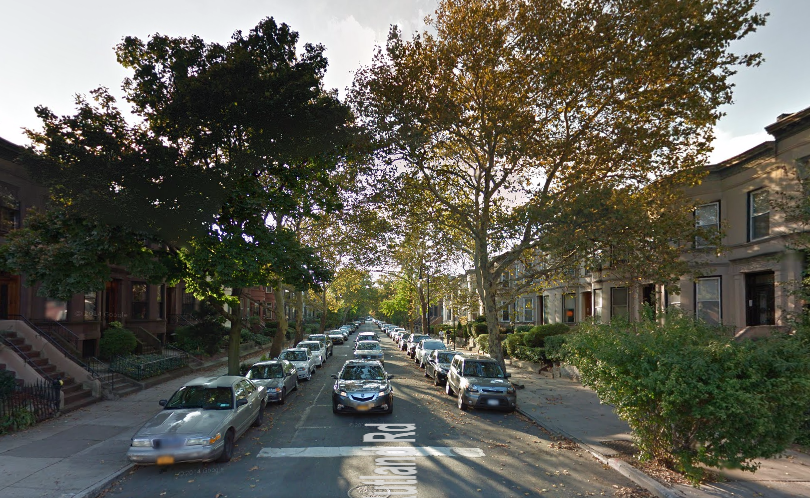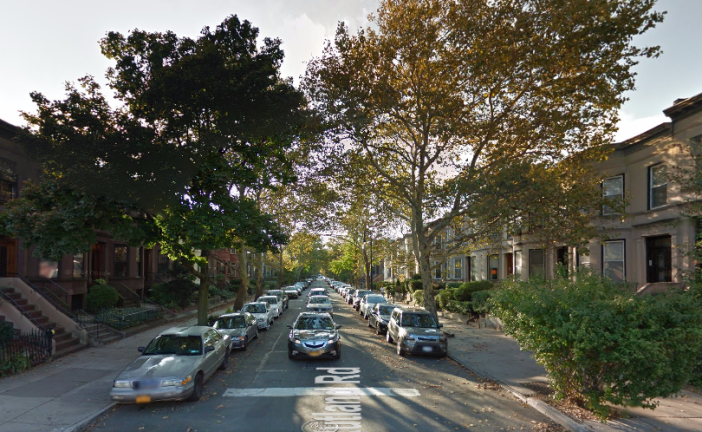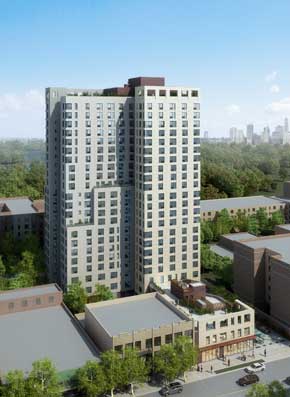Turmoil At Community Board Reflects Intensity Of Change In Brooklyn


The battle over gentrification and displacement has boiled to a head in Prospect-Lefferts Gardens/North Flatbush.
The early February removal of Tim Thomas, who chaired the transportation committee of the local community board, CB 9, has sparked more heated conversation about who controls the board and how it should respond to widespread fears that the area is about to be hit by a tidal wave of development which will lead to the displacement of many long-term residents.
Board 9, which covers Prospect-Lefferts Gardens, portions of North Flatbush, South Crown Heights, and Wingate, is one of several parts of Brooklyn in the midst of ongoing gentrification, displacement, and new development.
Board 9 Chairman Demetrius Lawrence removed Thomas from his post on February 5th, saying to Thomas in an email that he had taken action because of Thomas’ “lack of proper behavioral boundaries, inappropriate language, lack of decorum, and…overall combative personality.”
Thomas, a six-year veteran of CB 9, is “not a team player,” Chairman Lawrence said.
Thomas argues that he was actually the victim of a “smear campaign,” and that Chairman Lawrence was pressured into removing him by some community and board members who are resistant to discussions of development of any sort in the district.
In his written response to Chairman Lawrence, Thomas stated that Board 9’s transportation committee has new members who are “ALL [Thomas’ caps] antagonistic to me and to one proposal in particular – the Empire [Boulevard] Reconstruction Project of DOT [Department of Transportation].”
“This [discourse over the Empire Boulevard DOT project] led to the hostile environment, my vocal frustration, and ultimately my removal,” Thomas wrote in an email to board members, some residents and Borough President Eric Adams, who is responsible for appointing community board members.
The DOT has proposed to redesign the areas around Empire Boulevard’s intersections with Washington Avenue/Franklin Avenue and Utica Avenue/East New York Avenue to improve pedestrian safety, create new public space and improve traffic circulation. Measures like wider sidewalks and other large, continuous pedestrian spaces are under consideration.
“My future on the Board is not the point. The cohesion of the community and the opportunity for meaningful dialogue is being destroyed before our eyes,” Thomas continued.
Major Rezoning On The Horizon
The stakes are high for residents of CB 9.
Chairman Lawrence confirmed to us that CB 9 has given its consent — after much dispute — to the Department of City Planning (DCP) to initiate a “study” to look at the western half (from Prospect Park to New York Avenue) of the district, which could eventually lead to recommendations for a rezoning.
The hope is that in working with the DCP on the study, Board 9 can have a real influence on the City’s final recommendations and steer development in a way that serves the interests of residents.
While City Council members are able to vote yes or no on a neighborhood rezoning once it has been finalized by the City, community boards have a non-binding vote.
The City has already reportedly been looking at rezoning a one-mile section of Empire Boulevard, now lined with commercial uses like auto repair shops and storage facilities, for housing development.

The area under consideration on Empire Boulevard lies just off Prospect Park, on the border between Crown Heights and Prospect-Lefferts Gardens.
As many as ten luxury towers could be coming to Prospect-Lefferts Gardens, one of the most densely populated communities in Brooklyn, noted Crain’s back in 2014. The debate over the City’s plans for Empire Boulevard alone are “likely to deepen divisions within the community,” they reported.

Residents lost their fight against the construction of a 23-story residential building on the edge of the district, at 626 Flatbush Avenue, which can be seen looming over Prospect Park. Eighty percent of the building’s 254 units will be rented at market rate and twenty percent will have rents affordable to households earning 40 to 50 percent of the Area Median Income, says the developer.
Breakdown In Dialogue
The removal of Tim Thomas has sparked an outpouring of comments over the current situation within the board.
“Chairman Lawrence is in a tough spot,” Daniel Kristjansson, a member of the transportation committee, said to us in an email, arguing that the “board was divided against itself.”
Of particular concern, said Kristjansson, is the role of area resident and community activist Alicia Boyd, who spearheads the advocacy group Movement To Protect The People (MTOPP).
Boyd, who did not respond to requests for comment for this story, is not a member of Board 9 but has been an active participant in board discussions.
Over the last two years, Boyd has charged that Board 9 does not operate in a transparent manner, has been slow to welcome more participation from community residents, and should not cooperate with city studies that would pave the way for a neighborhood rezoning.
Kristjansson described Boyd as a “demagogue.” She “has successfully incited infighting within the CB 9 to the point of paralysis. Tim Thomas is one of the few members of the board who has the courage to stand up to her attacks and accusations,” Kristjansson said.
(A community member who is not on the board, but has attended several CB 9 meetings, echoed Kristjansson’s statement to us but would only do so off the record.)
CB 9 Chairman Lawrence pushed back strongly against the claim that the board is being unduly influenced by MTOPP or any other group. “The board has not been hijacked,” he said.
“With regards to Alicia Boyd,” Lawrence continued, “she as well as other community members’ opinions are respected and taken into consideration. We as a board and a governing body will not tolerate anyone harassing or disrupting our monthly general meetings; as Ms. Boyd has attempted in the past.”
But, Lawrence acknowledged, Boyd, along with some board members, including Karen Fleming, have “pointed my attention to some concerns they’ve had with Tim [Thomas].”
In an email to us, Karen Fleming said that she had “presented a Bill of Particulars to the Executive Committee of CB9 requesting the REMOVAL OF TIM THOMAS as CHAIR for FABRICATING A VOTE.” [Fleming’s caps]
We were not able to get any more information from Fleming before publication about what her bill entailed.
Thomas, who is white, states (and details in his blog) that discussions with Boyd had deteriorated to the point in which Boyd called some of his actions racist and a petition was circulated, demanding his removal. Chairman Lawrence told us he was unaware of such a petition.
Another member of CB 9’s transportation committee, who asked not to be identified, said to us that many of the complaints raised about Thomas were “made-up. Tim’s the only one who has really stood up to Alicia,” the committee member said and added, “Chairman Lawrence over-reacted.” But, the committee member added, these were historic tensions and the committee is already trying to move forward.
The Real Battle
While a rezoning looms and developers circle around the area, the fundamental question is whether CB 9 can respond effectively and in a unified fashion. There is a real lack of consensus, for example, as to whether steering new development toward Empire Boulevard would be good or bad for the district.
Celeste Davis, who was a Prospect-Lefferts Gardens resident for 27 years and active in the community, said that attacks on individual Board 9 members (who are also neighbors) by MTOPP and others did not create any meaningful results for area residents.
Davis, who moved out of the neighborhood last June, said there was real merit to questions about the impacts of a rezoning and the intentions of developers. But CB 9 needs “productive dialogue,” she said, not behavior that is “injurious and disruptive,” if it is going to be able to fight on behalf of the community.
Quest Fanning, who is president of the Prospect-Lefferts Gardens Neighborhood Association and also a member of the CB 9 transportation committee, said that the association is watching the experience of other neighborhoods who have been rezoned by the City, such as Greenpoint-Williamsburg, with great trepidation. Renters in CB 9 are already being forced out by landlords using “highly questionable tactics,” he said.
The debate within Board 9 about how to proceed, Tim Thomas argues, is “much deeper and older” than disagreements about one particular project. “It’s about Old Brooklyn and New Brooklyn colliding,” he said.
Thomas described a “New Brooklyn” which is more open to phenomena like tech and restaurant culture, and new construction. And while race plays a huge role in this battle for what Brooklyn will become, who is a “gentrifier” and who is an “old timer” does not always fall along racial lines, he argued.
In the meantime, residents of CB 9 ponder the future of their beloved — and historically diverse — community. Several of them posed the same question to us that Thomas asked: is there a way to “get us all sitting down and talking to each other again?”



